Nikki Beach Porto Heli Welcomes Summer
Blending laid-back luxury with coastal charm,...
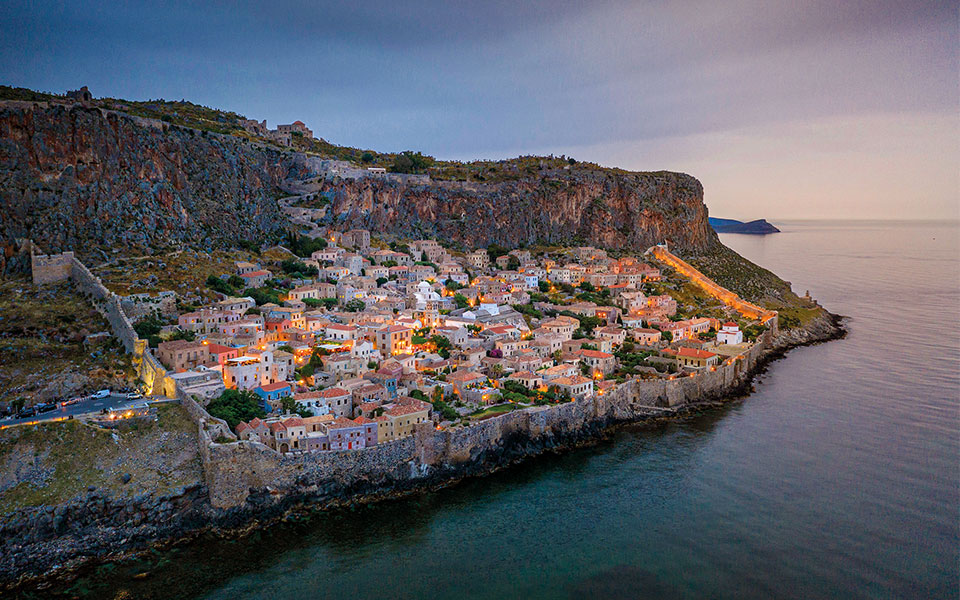
The atmosphere at night is absolutely charming, as the lights inside the wall delineate the old town.
© Visualhellas.gr
The fortress town of Monemvasia is always charming, whatever the time of year. The medieval setting, the winding cobbled streets, the old masonry and subdued lighting, the sea and the absence of cars make it feel as though you’ve traveled back in time. The sense of being on a rock that is connected to the mainland Peloponnese only by a narrow causeway only heightens the atmosphere.
Monemvasia is, in short, one of those places that everyone must visit at least once. And if you have to pick a season, that would be spring – when the weather starts to warm up and Greek Orthodox psalms for Easter echo across the rock. Indeed, Easter week is a truly magical time to be in Monemvasia, to experience the solemn services at the Church of Aghios Nikolaos on Holy Thursday, and the candlelit procession of the Epitaphios from Chryssafitissa and Myrtidiotissa on Good Friday, as it winds its way around the town’s streets, through the colonnades, to reach Ano Poli (the “upper town”) and the Church of Agia Sofia via the “voltes,” the local name for the beautiful snaking path up to the old quarter. Whether the procession will reach Ano Poli this year is something that will be decided at the last moment, but even if it doesn’t it is a beautiful custom.
The Epitaphios, a lavishly decorated icon representing the funeral bier of Christ, accompanied by the municipal philharmonic band playing the psalms, stops briefly at every church along on route, at the fortress town’s most important building (the Ardamis guest house, once the government house of the Venetians and the administrative headquarters of the Ottomans) and at the main gate. Then it crosses the causeway, with local fishermen lighting lanterns to guide it on its way into the village across the bridge, where it then makes its way to the Church of Agios Leontios.
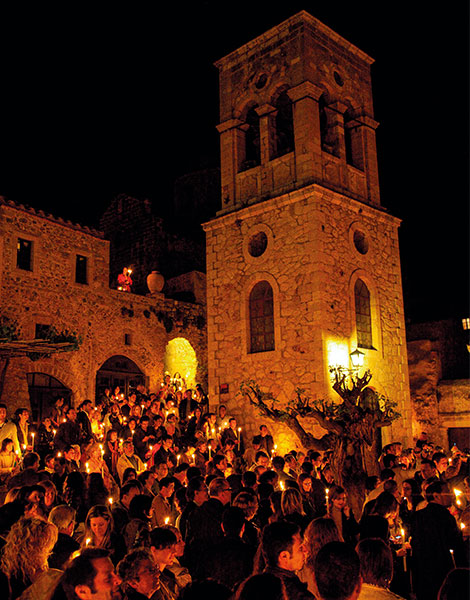
A powerful sense of spirituality pervades the Church of Christ in Chains (Elkomenos Christos), which is currently undergoing restoration.
© Visualhellas.gr
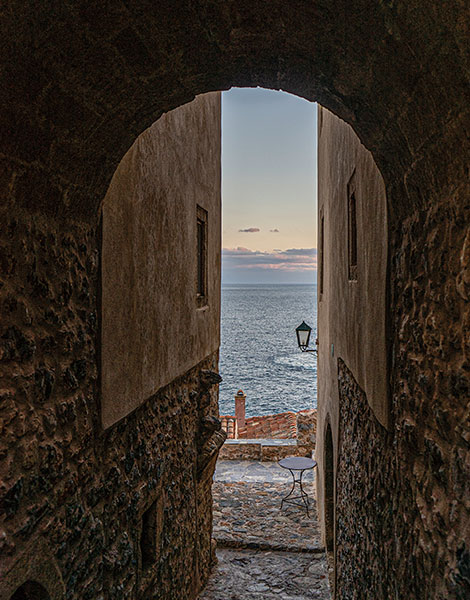
The medieval gates and narrow openings give you stunning views of the Myrtoo Sea as you wander around the cobbled paths of the fortified settlement.
© Marika Tsouderou
Monemvasia celebrates the Resurrection on Easter Saturday in an equally quiet and peaceful manner, as the customary firecrackers are banned in the town, which is listed as a protected historical site. The metropolitan Church of Elkomenos Christos, where celebrations are usually centered, is currently under restoration, so Chrysafitissa will be hosting this year’s event. Observing the ceremony at an actual historical monument is something quite special, regardless of one’s religious beliefs.
The tranquil atmosphere ends on the afternoon of Easter Sunday, when “disturbing the peace” is permitted for the sake of another special custom: the loud, ceremonial burning of a Judas effigy in the courtyard of Chrysafitissa, with a view of the sea.
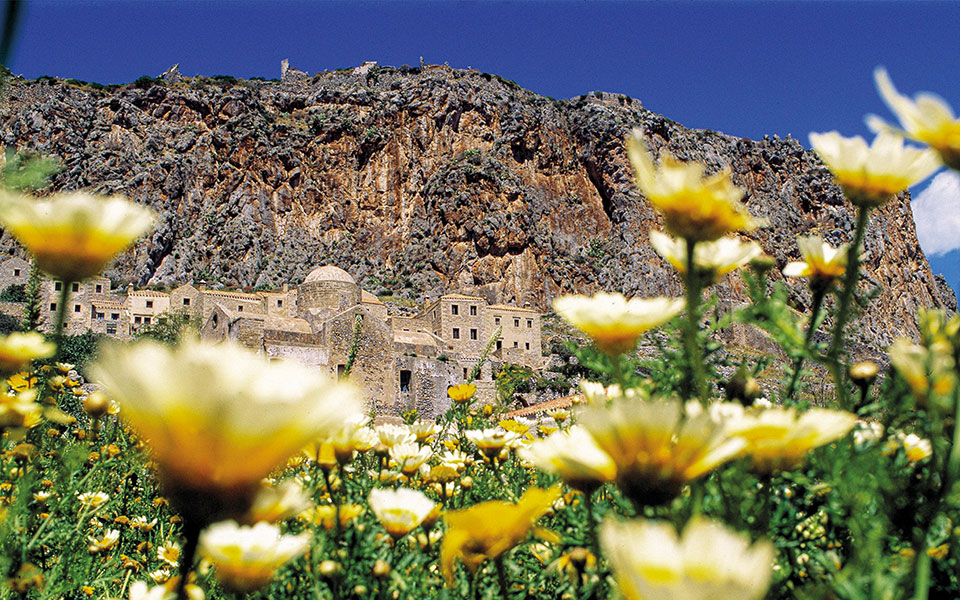
Spring is the best time to visit the medieval fortress town of Monemvasia.
© Tophoven/Laif
Strolling around the medieval fortress town is something you simply cannot tire of. Tiny side streets, covered passages, Byzantine churches and elegant townhouses make you feel like a character in a fairytale. The central road, which is flanked by restaurants, cafes, gift shops and delis selling local products, is named after the award-winning Monemvasia-born poet Yiannis Ritsos. His home is in the process of being transformed into a museum on his life and work, showcasing all sorts of memorabilia (furniture, paintings, poetry collections, etc. donated by his daughter, Eri Ritsou, to the municipality).
The road will also take you the main square and to the 6th century Elkomenos Christos (Christ in Chains) Church (currently under restoration, but do ask about the history of the icon of the Crucifixion), and the much-photographed canon pointing out to sea. The mosque on the square hosts the small but interesting archaeological collection of Monemvasia.
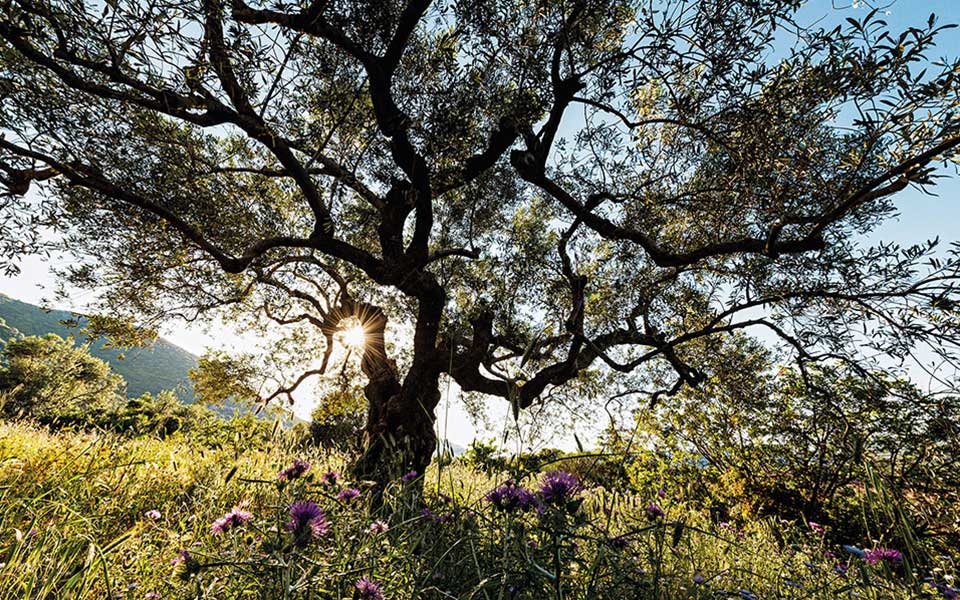
A landscape of olive groves and blossoming wildflowers beckons outside the fortress walls.
© Thomas Linkel/Laif
Plans are under way to build a cable car up to Ano Poli. Authorities say that the construction will respect the fortress town’s history and character, but if you are able, it is definitely worth making the walk up the lovely cobbled path, which affords a great view of the town below and the sea beyond, while also taking you past the pretty 12th century Church of Aghia Sofia. Another great walk inside the fortress is along the seaward wall. It takes you to the Portello gate towards the sea (if the weather is warm enough you can even have a dip here), then to the gate of the eastern wall and then on to the restored lighthouse.
Gefyra, on the opposite coast, is a modern settlement that is only worth visiting, really, for the view of the rock and to shop for the famed local almond biscuits from Moreos Idista. A bit further afield, the road to Sykia will take you to the Monemvasia Winery, where the Tsimbidis family is doing a great job with the revival of the sweet Malvasia grape and organizes tastings.
Make sure you’re back inside the fortress walls by nightfall so you can roam the beautiful streets, enjoy a meal of local dishes (like goges pasta or tsaitia pies) and wrap up your day with a cocktail on the small rooftop veranda of the bar Emvasis (Tel. (+30) 27320.611.39).
Kinsterna (Tel. (+30) 27320.663.00, from €211 with breakfast and a minimum two-night stay) is a mansion from the Byzantine era situated in a 9-hectare garden with olive trees, oranges and grapevines, overlooking the sea and the rock of Monemvasia. It has been tastefully and respectfully restored, and offers rooms, suites and independent apartments, all elegantly decorated in a style of understated luxury. The restaurant and breakfast selection use ingredients grown on the estate, while you can also participate in agritourist activities like candle-making and tasting to cycling and fishing excursions.
Ardamis (Tel. (+30) 27320.618.87, from €115, without breakfast), is in one of the most historic buildings inside the fortress town, the administrative headquarters of both the Venetian and the Ottomans. It offers a variety of rooms and suites, which are all tastefully decorated, come with branded care products, and include a hot tub. The main building has a gorgeous veranda with an open view of the sea.
Moni Emvasis Luxury Suites (Tel. (+30) 27320.621.22, from €190, with breakfast), offers three lovely suites inside the castle. They are well furnished and boast a fireplace and sea view.
Kelia (Tel. (+30) 27320.615.20, from €95, with breakfast), is a pretty guesthouse situated in the building where poet Yiannis Ristos was born. The rooms are on the ground floor and on the floor above, which offers sea views. The proprietors also organize tastings of locally produced olive oil and wine.
Malvasia (Tel. (+30) 27320.613.23, from €95 with a sea view or 65 euros from the smaller units, all with breakfast), offers rooms of different types and sizes. Some have a sea view, others have a balcony, and others a fireplace.
Vyzantino (Tel. (+30) 27320.613.51, from €90, with breakfast) is very well situated on the main road. It is split up between different buildings and offers a variety of rooms with modern amenities, most with a sew view. It also has its own café and serves a Greek breakfast.
Likinia (Tel. (+30) 27320.619.39, from €120, with breakfast) is in a prime location on the square of Chrysafitissa Church. Its rooms and suites are equipped with modern amenities, and most have a fireplace and a sea view.
Liotrivi (Tel. (+30) 27320.530.60, from €103, with breakfast) is in the nearby village of Velies, in a building that is said to have been Yiannis Ritsos’ summer home. The rooms and suites are tidy and clean, with a view over the olive garden. There is also a traditional oil mill and a small museum on the site.
Monemvasia is a listed historical site and the Ministry of Culture controls any interventions on the buildings, which are governed by strict guidelines. This means that many hotels and guesthouses have not been restored to the extent that their proprietors would have liked and there may be disparities in the quality and size of the rooms they offer. It is important, therefore, to know exactly what you’re paying for in advance.
Blending laid-back luxury with coastal charm,...
Four guesthouses set in unique landscapes,...
Six Athenians tell us about their...
A historic hotel redefines modern Greek...